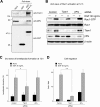Involvement of 14-3-3 proteins in the second epidermal growth factor-induced wave of Rac1 activation in the process of cell migration
- PMID: 21868386
- PMCID: PMC3234750
- DOI: 10.1074/jbc.M111.255489
Involvement of 14-3-3 proteins in the second epidermal growth factor-induced wave of Rac1 activation in the process of cell migration
Abstract
Immense previous efforts have elucidated the core machinery in cell migration, actin remodeling regulated by Rho family small GTPases including RhoA, Cdc42, and Rac1; however, the spatiotemporal regulation of these molecules remains largely unknown. Here, we report that EGF induces biphasic Rac1 activation in the process of cell migration, and UTKO1, a cell migration inhibitor, inhibits the second EGF-induced wave of Rac1 activation but not the first wave. To address the regulation mechanism and role of the second wave of Rac1 activation, we identified 14-3-3ζ as a target protein of UTKO1 and also showed that UTKO1 abrogated the binding of 14-3-3ζ to Tiam1 that was responsible for the second wave of Rac1 activation, suggesting that the interaction of 14-3-3ζ with Tiam1 is involved in this event. To our knowledge, this is the first report to use a chemical genetic approach to demonstrate the mechanism of temporal activation of Rac1.
Figures






References
-
- Lauffenburger D. A., Horwitz A. F. (1996) Cell 84, 359–369 - PubMed
-
- Pollard T. D., Borisy G. G. (2003) Cell 112, 453–465 - PubMed
-
- Small J. V., Stradal T., Vignal E., Rottner K. (2002) Trends Cell Biol. 12, 112–120 - PubMed
-
- Yamazaki D., Suetsugu S., Miki H., Kataoka Y., Nishikawa S., Fujiwara T., Yoshida N., Takenawa T. (2003) Nature 424, 452–456 - PubMed
-
- Blanchoin L., Amann K. J., Higgs H. N., Marchand J. B., Kaiser D. A., Pollard T. D. (2000) Nature 404, 1007–1011 - PubMed
Publication types
MeSH terms
Substances
LinkOut - more resources
Full Text Sources
Other Literature Sources
Research Materials
Miscellaneous

